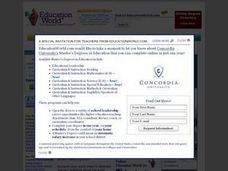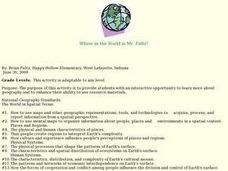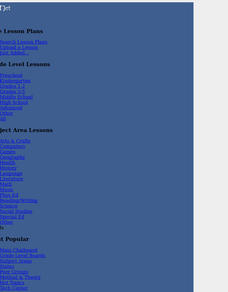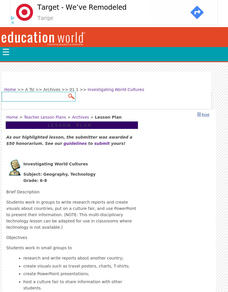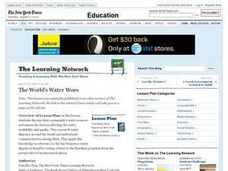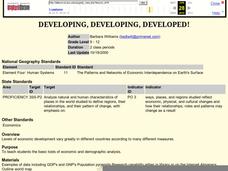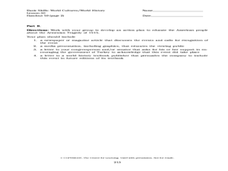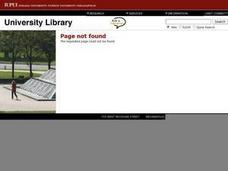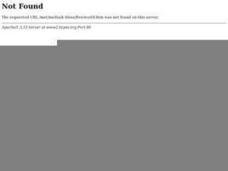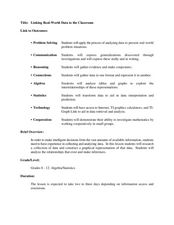Curated OER
A World of Information
Students analyze data and statistics about countries around the world. They read graphs and charts, color a world map to illustrate the top ten statistics about the world, and write a paragraph to summarize their information.
Curated OER
Where in the World is Mr. Fultz?
Students use maps and other geographic resources to learn about their world while problem solving. They read clues each day and use classroom resources to narrow down where the prize is located.
National First Ladies' Library
Let's Make a World Series Almanac
Middle schoolers discuss the meaning of the word, almanac and then decide which statistics about the World Series they think should be included in the almanac, browsing some websites to get some idea of what statistics are available....
Curated OER
Animals in the Almanac
Students practice using a World Almanac by completing the provided worksheet on animals.
Alabama Learning Exchange
Using an Almanac
Young scholars work cooperatively in order to identify specific situations in which an almanac is the best choice for locating information. They answer specific questions, record the page on which the answer was found, and the key words...
Curated OER
Investigating World Cultures
Middle schoolers, in groups, write research reports and create visuals about countries, put on a culture fair, and use PowerPoint to present their information.
Curated OER
The World's Water Woes
Students discuss their community's water sources and assess the factors affecting the water availability and quality. They research water disputes around the world and explain common factors among them.
Curated OER
Four Corners Mystery: Where In The World Are We?
Students research and describe various locations around the world using five fundamental themes of geography.
Curated OER
We Are One World
Learners access prior knowledge to choose a country and research the living conditions in that country. In this living conditions lesson, students recognize the differences and similarities of conditions of another country to ours....
Curated OER
Developing, Developing, Developed!
Students differentiate among and explain various levels of economic development around the world. They see that levels of economic development vary greatly in different countries according to many different measures.
Curated OER
The Fall of the Roman Empire and the Armenian Tragedy of 1915
Young scholars examine the fall of the Roman Empire and the Armenian tragedy. In this world history lesson, students read handouts about both world history events and create presentations that feature the events.
Curated OER
Studies of the Eastern Worlds: Population Graphing
Seventh graders participate in several learning/research stations in which they view artwork from various countries of the Eastern world and collect information on the populations of the Eastern countries. They then use this information...
Curated OER
Famous Landmarks
Learners research a country and the national holidays the people of that country celebrates. In this cultural celebrations lesson, students are assigned a country, research the major holidays of that country, and create a 12-month...
Curated OER
The World Almanac for Kids
Fifth graders identify and compare the features of The World Almanac for Kids in the print form and in the CD-ROM/ on-line form. They predict which format is the easiest to access and the most informative, then draw conclusions from...
Curated OER
Reference Materials
After a class discussion where kids share how they find answers to their questions, learners explore the world of reference materials such as, an atlas, an almanac, and an encyclopedia. The Internet is also discussed as a way to access...
Teach Engineering
Weather Forecasting
According to the Farmers' Almanac, the weather will be nice today. Class members examine how weather forecasting plays a part in their lives with a resource that provides information on the history of forecasting, from using cloud...
Curated OER
Presidents
Fifth graders explore using almanacs for research purposes. They use the almanac to look up a variety of information including the presidents of the United States.
Curated OER
The Timeline of a Lifetime
Students create a timeline which includes four important events from their own life, two national events and two world events. They write an essay highlighting the four events included on the timeline.
Curated OER
The Designed World
Learners study the classification system used in a library. In this sorting and classification lesson, students visit their library and define the classification system in place. Learners discuss the sorting method and then come up with...
Curated OER
Virginia In the World: The Geography of Commerce
Young scholars examine how Virginia connects with the world through export trade. Using a map, they use symbols to depict the value of trade and the direction of the flow of goods. They complete a scavenger hunt using electronic almanacs...
Curated OER
Legacy of Colonialism
Students explore the extent of colonialism from the early periods in the 1500's to the later years in the mid 1900's. They explain how colonization differed in regions around the world and examine the lasting effects on the colonized...
Curated OER
The Role of Philanthropy in an Ever Changing World: Where Did it all Start? Time-lines of History
Students create timeline to trace the history and development of the selected organization, and compare the history of the selected organization to actual historical events.
Curated OER
Leapin' Landmarks: Locating 10 Man-made Landmarks Around the World
Third graders label continents, oceans, and major mountain ranges on maps and use the maps to write an informational report about landmarks. In this landmarks lesson plan, 3rd graders write about 1 major landmark.
Curated OER
Linking Real World Data to the Classroom
Students analyze data representing real life scenarios.In this algebra lesson, students collect, plot and analyze data using a graph. They use different methods to represent and present their data.


